Charles Burki
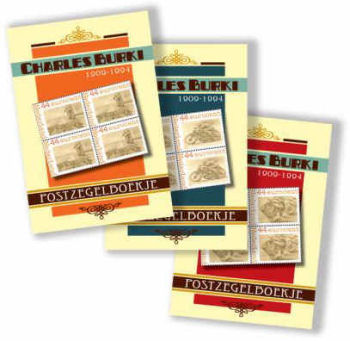 On March 6th 2010 TNT post has issued a serie of 3 stamp booklets with images of motorcycles, drawn by Charles Burki. Each booklet contains 8 identical stamps of 44 cents of the so-called 'fixed frame' type. These are the stamps that look the same as the well-know personalized stamps (in this case the ones with orange letters), but are issued by TNT itself and thus for sale for everybody. On March 6th 2010 TNT post has issued a serie of 3 stamp booklets with images of motorcycles, drawn by Charles Burki. Each booklet contains 8 identical stamps of 44 cents of the so-called 'fixed frame' type. These are the stamps that look the same as the well-know personalized stamps (in this case the ones with orange letters), but are issued by TNT itself and thus for sale for everybody.
The occasion for the issue of these Burki stamps is the exhibition 'Behind the Kawat' in the Museon in The Hague, Netherlands. This exhibition is about the life of Charles Burki in a Japanese prisoners of war camp in the 2nd world war.
In fact the name Burki did not ring a bell to me, so I started to look what kind of person he was. And this proved to be very interesting…
Charles Burki was born on May 4th 1909 in Magelang, Mid-Java. He grew up in the Dutch East Indies (nowadays Indonesia), but after finishing his higher education in Bandung in 1929 he came to the Netherlands to study building engineering at the Technical University in Delft, where he also met his later wife. Next he studied at the 'Ecole des Beaux Arts' in Paris to learn drawing and painting.
In 1938 he went on his honeymoon back to the Dutch East Indies on a 500cc Norton International with sidecar. Together with his wife Sophia he stayed there, but after Japan had declared war upon the Netherlands the couple was made prisoner of war in March 1942. Charles Burki was put in prison in a camp in Bandung, but in 1943 after 14 months transferred to Japan as convict.
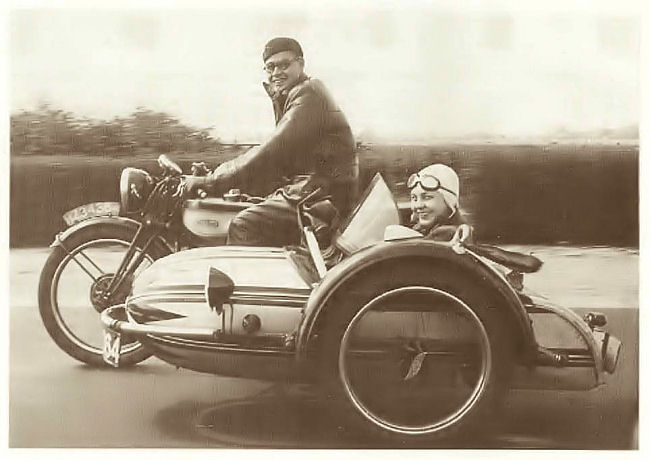
Charles and Sophia Burki and their Norton with sidecar
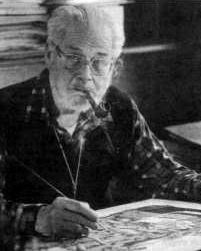
He made the journey to Japan on the freight ship Tomahuku Maru. Within sight of the harbour however this ship was torpedoed by the Americans. Burki was one of the few survivors of the prisoners that were locked in the holds of the ship. After being picked out of the sea by a Japanese ship he was transferred to a labour camp in Nagasaki. On August 9th 1945 the Americans dropped the first atomic bomb (named 'Fat man') there, only 2 kilometers away from the labour camp where Burki was. He survived this as by a miracle, with only 2 holes burned in the back of his coat!
After the war in December 1946 he found his wife back in a fugitive camp in Balikpapan, and the couple returned to the Netherlands. Finally Burki died in 1994 in The Hague.
During his whole life Charles Burki has made drawings. His work was very diverse. He worked for example as advertisement drawer, illustrator and designer. During his imprisonment in the war he secretly recorded the daily life in the camp in drawings. This was very dangerous, because when caught the Japanese would have punished him heavily on suspicion of espionage.
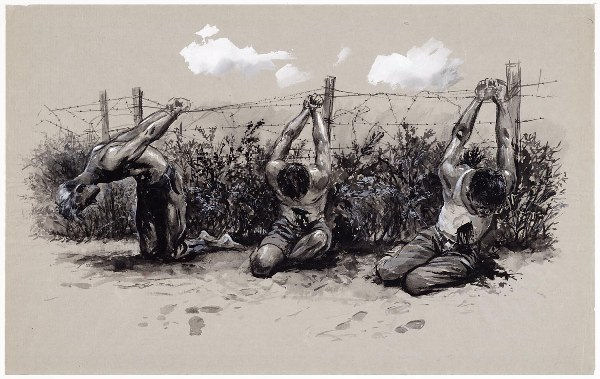
Before his departure from the camp in Bandung he safely put away his drawings with help of a friend. Rolled up he packed them in hospital cloth, next in a zinc can that finally was put in a tarred wooden box. They buried the box in the passage of a gateway in the camp. For many years everybody walked over them, and finally in 1946 the drawings came back to Burki by the help of a friend that had dug them up on Charles' request.
These drawings are exposed at the exhibition in the Museon. Together with the stories behind them they give a shocking impression of the horrible things that happened in the camp. But at the same time they illustrate the ingenuity and many, sometimes even funny, incidents.
Part of the drawings have been published by Burki in 1979 in the book 'Behind the Kawat' (Kawat is the Indonesian word for barbed wire). On the occasion of the exhibition with the same name a revised version of the book has been issued.
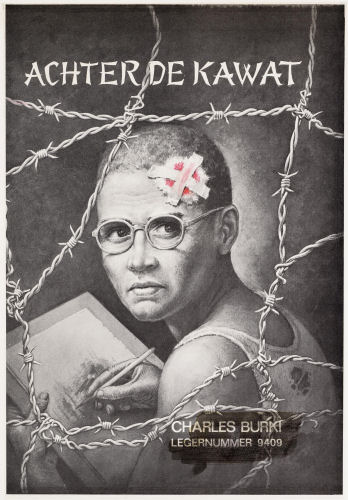
From his childhood up Burki has been very interested in technology and speed. This expressed itself amongst others in his passion for motorcycles. Obviously he had an excellent memory for all sorts of details, because he also drew motorcycles in the Japanese war camp, off course without any example. How realistic his drawings were is proven by the stamps, as the images on them are sketches from the period of his imprisonment! Thus completely drawn from memory.

His technical interest also determined for a large part the contents of his works. He worked for instance as illustrator for the Dutch motorcycle magazine 'Motor'. In this work he gave room to his imagination, as is proven by the sometimes hilarious drawings of revolutionary 'inventions'.
However, Burki was also famous for his very detailed technical drawings and 'ghost views', that were used to elucidate many article.
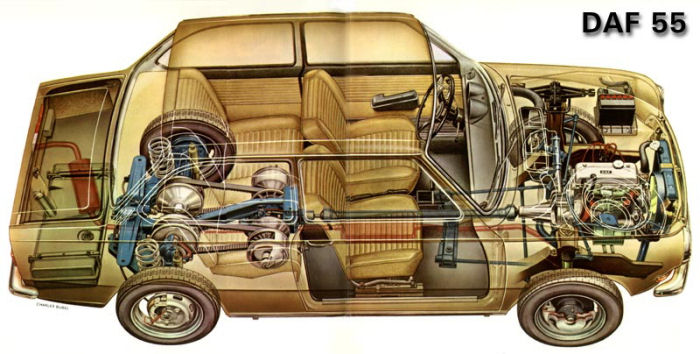
Also the Daf company made use of his talents, and let him make drawings for, amongst others, advertisements and brochures. An example of this is the drawing of the first Daf family car (mostly called 'Dafje' in Dutch), that was used by TNT for promotion of their thematic stamps series 'The years 50-60-70' that has been described by Hans in the previous newsletter.
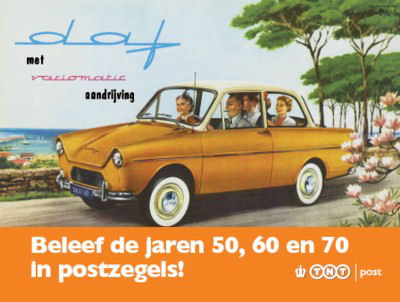
Also in his work for Daf, Burki could not switch of his fantasy. This resulted amongst others in a drawing of how the famous Daf family car should have looked according to Burki.
But Charles Burki also made complete designs for car and two-wheelers. Unfortunately almost none of his designs has been realised, probably because his rich imagination made them too far ahead of their time. He designed for instance around 1950 a small drop-shaped car with only 3 wheels, and motorcycles with full polyester enclosures, including bumpers all around.
A design that actually has been realised is the Union Boomerang moped. Also that moped was very modern for its time, and certainly not common, but obviously this did not prevent that it was put in production. Off course Burki not only made the design, but also made the drawings for the brochure.
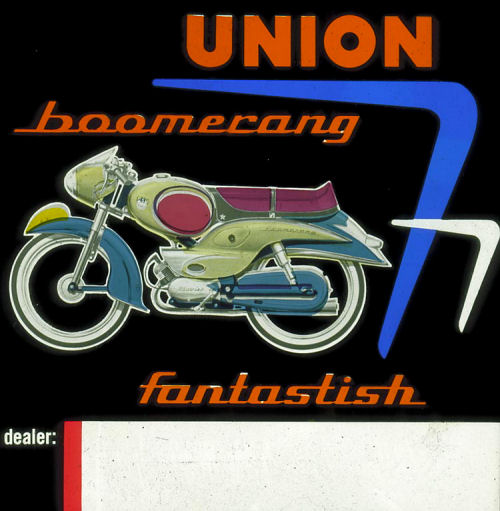
The Union Boomerang. Also this brochure ahs been drawn by Burki
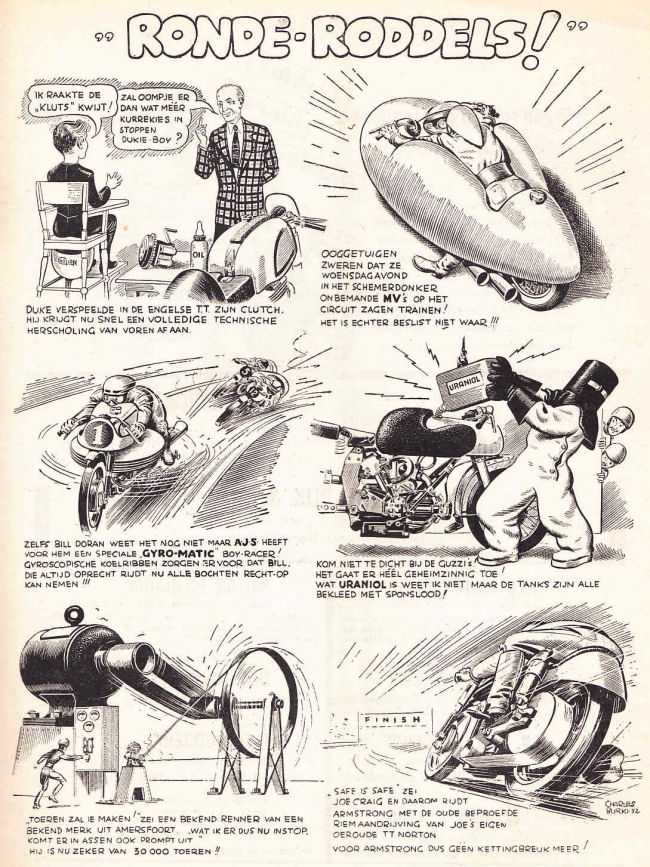
A nice example of the imagination of Charles Burki. Page out of the TT-issue of the magazine Motor from 1952
All together we can state that Charles Burki was a versatile artist, with a very creative mind and an excellent feeling for technology. Especially on the subject of mobility, both on 2 and more wheels, he has delivered quite a lot of nice work. This inspired Vincent Denters in 1997 to write the booklet 'The art of motorcycling' (in Dutch: De kunst van het motorrijden), about the life and work of Burki.
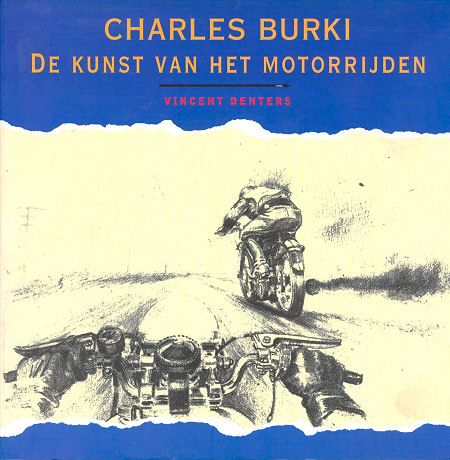
Also TNT has obviously recognized that Burki was a skilful motorcycle drawer, and this is why 3 of his motorcycle drawings have been chosen to depict on their stamps. Off course we, as motorcycle philatelists, are very happy with this choice and therefore we grabbed the opportunity to frank this newsletter with one of the 3 stamps. The 2 others will be used for sending later newsletters.
Paul Essens
Also the logo of the 'ZZ races' ('t Zand-Zeerijp races in the North-Eastern part of the Netherlands) is from Burki's hand:

The ZZ-races logo.... and the original drawing of Charles Burki
Top - Back to former page - Home |